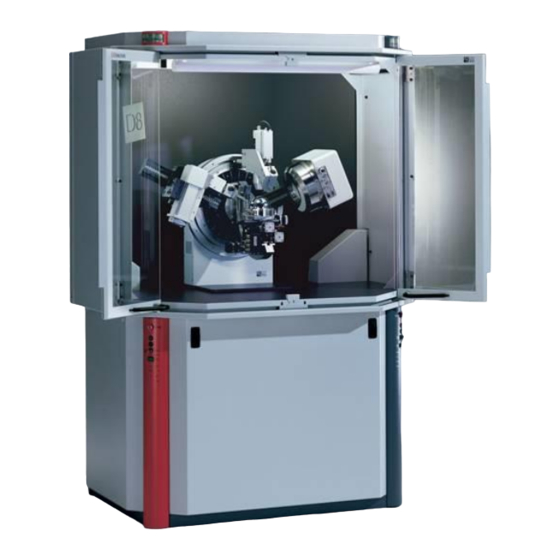
Bruker D8 Discover Standard Operating Procedure
X-ray diffractometer
Hide thumbs
Also See for D8 Discover:
- Standard operating procedure (12 pages) ,
- User manual (96 pages)
Advertisement
Quick Links
Bruker D8 Discover X-Ray Diffractometer
(You MUST be trained by an authorized BSCMC trainer to use this instrument)
Hazards:
This unit produces a high intensity X-ray beam. Take all precautions to avoid exposure to the x-rays.
Warning:
Beryllium! Do not touch the front window of either detector as they both contain Beryllium. Fumes
of the dust from Beryllium and its compounds can be hazardous if inhaled!
Typical Experiment Sequence:
1. Sign in on the iLab electronic calendar
2. Visually check the diffractometer for instrument status.
3. Open the cooling water valves and turn the x-ray generator ON.
4. Launch the D8Tools software to check the system status and ramp the power up.
5. Launch the operating software:
a. GADDS for use with the HI-STAR area detector
b. Commander for use with the Scintillation detector.
6. Check the x-ray beam intensity
7. Load and align sample
a. Use the Laser-Video System with GADDS and the HI-STAR area detector
b. Use a Z-scan and half intensity method or the Laser-Video System with
Commander and the Scintillation detector.
8. Set up scan and save data.
9. Remove sample, reduce power, turn the generator off and shut off the cooling water
10.
Be sure that the iLab calendar accurately displays the number of hours the XRD was
OCCUPIED by your experiment.
Standard Operating Procedure:
Advertisement

Subscribe to Our Youtube Channel
Summary of Contents for Bruker D8 Discover
- Page 1 Standard Operating Procedure: Bruker D8 Discover X-Ray Diffractometer (You MUST be trained by an authorized BSCMC trainer to use this instrument) Hazards: This unit produces a high intensity X-ray beam. Take all precautions to avoid exposure to the x-rays. Warning: Beryllium! Do not touch the front window of either detector as they both contain Beryllium.
- Page 2 Procedures for ALL X-Ray Diffraction Experiments on the Bruker D-8 Discover: Sign in on the electronic calendar at https://boisestate.ilabsolutions.com Visually check the diffractometer for instrument status. Check the machine status on either left or right column before using the machine. The “On” light should be on.
- Page 3 iii. Power ON button: It switches on the control electronics, the high voltage generator and all components connected to the AC outlets. High Voltage- Rotary Switch: Used for turning high voltage on or off. Open Door button: Functions the same as the button on the left column vi.
- Page 4 c. Then physically look at the drive to determine which way it needs to go in order to be at the reference position i. If it needs to go in the positive direction to fulfill the reference position, push the find reference up button. Likewise, if the drive needs to go in the negative direction, push the find reference down button (→...
- Page 5 Procedures for ALL X-Ray Diffraction Experiments using the HI-STAR area detector: 4. Launch the operating software: a. Open the GADDS program for use with the HI-STAR area detector (It will prompt “set generator to user setting: 40 KV and 40 mA” →Click Yes) b.
- Page 6 c. Make sure that the detector receives around 6,000 counts or more. If not, please contact an authorized BSCMC trainer. 6. Load and align the sample (The Laser-Video System has to be used with the HI- STAR area detector) NOTE: Things to be careful of when loading your sample: •...
- Page 7 o These are precisely aligned to give you “good” data • Do not bump the X-ray optics o A very slight bump could result in a loss of 30% of your beam intensity a. Open the doors to the XRD (Push Open Door button on either side of control column, then open the window.) b.
- Page 8 iv. The Manual controller has two functions: 1. Command (set point) mode (access by pushing the “F1/DRVC” button on the controller) a. Enter three commands (Drive #, Instruction, Location) i. Drive # is where the drive you want to move is called on ii.
- Page 9 1. The laser might be difficult to see on reflective samples. If this is the case, move Chi/psi to 22.5 degrees (splitting the angle between the laser and the video) to cause the laser to reflect back into the camera. Zoom = 1X Zoom = 7X Always leave one finger on “ESC/STOP”...
- Page 10 7. Set up a scan and save data: a. If you have already not done so, Create a new project folder (→ Project, →new, input information accordingly. Use the working directory C:\Frames\”year”\”month”\”Sample Name” (This automatically saves subsequent data collections to the above file path)) b.
- Page 11 d. Set up for the data that you want to collect: i. Active field descriptions: • # Frames: How many frames of diffraction will be collected • Seconds/Frame: How long the detector will be exposed for each frame • Scan Axis #: This is which position/drive that will change between subsequent frames o The value “Coupled”...
- Page 12 7. Z: Use “ ” 8. Aux: Use “ ” (this is the camera zoom) • Scan Axis #: Coupled • Frame width: 20-30 (depending on the amount of overlap desired on integration) • Mode: STEP • □ Rotate Sample: Typically not used for powder diffraction •...
- Page 13 8. Remove sample. a. Take your sample out of the XRD (the BSCMC is not responsible for lost and/or damaged samples) 9. Close the GADDS operating software and leave the unit in standby mode (20kV, 5mA) → → Project, Exit 10.










Need help?
Do you have a question about the D8 Discover and is the answer not in the manual?
Questions and answers